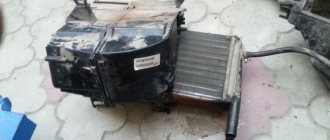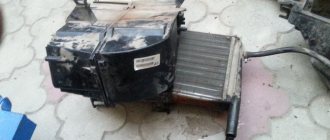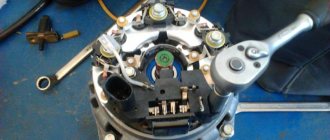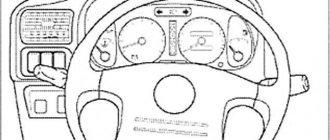And yet: is it necessary to close the car radiator in winter and the relevance of the “cardboard”
Theoretical effect
It is better to learn how to properly close the radiator for the winter from experienced drivers. There’s nothing complicated about it, but some extra advice won’t hurt. Be interested in what and how, preferably after mastering it, why it is needed and getting an answer to the question whether this method of insulation actually helps. Making a final decision is possible only if the needs of the owner and the guarantees of this method of thermal insulation coincide.
Restricting air access to the engine through the radiator grille in winter gives:
- Reducing the time it takes to fully warm up the engine during frequent short trips.
- Acceleration of coolant reaching operating temperature when warming up the power plant while driving.
- Preservation of heat in the engine compartment when driving on the highway.
Practical significance
Premium cars have long been equipped with a system of dampers that regulate the volume of air flowing over the engine. Ensuring that the power plant quickly reaches operating temperature and maintaining it within specifications helps preserve the factory life of internal combustion engine parts.
Natural thermal conditions in cold weather are only beneficial and here’s why:
- Reducing the warm-up time leads to a decrease in fuel consumption, since the ECU generates an over-rich mixture when it is cold.
- Reducing the proportion of air cooling at high speed allows the interior heater to operate at full capacity.
The help of insulation is especially noticeable at temperatures below -20°C: the computer displays suburban fuel consumption values close to summer values, and the stove heats up noticeably even at idle. This fact is confirmed by both owners of carburetor cars and owners of injectors. However, you can only get by with an additional homemade car interior heater designed for 12 Volts.
The position of companies specializing in the production of insulating components is clear. Often, when asked whether it is necessary to close the radiator in winter, they put forward additional arguments in favor:
- Fuel savings up to 25%.
- Eases cold starts.
- Increased battery life.
It is quite clear that the savings percentage is overestimated, and the closed radiator grill does not affect the morning start-up in any way - the engine managed to freeze overnight. There is also no gentle operation of the battery, since you still have to turn the crankshaft in thick oil.
pros
- Reduces the risk of hypothermia . The main reason for installing this system is to counteract the risk of freezing. On the other hand, no one says that if you do not install insulation, you are 100% doomed to breakdowns. Observations have shown that a car with an insulated radiator feels better in cold weather than an uninsulated one. This is a pretty strong argument in favor of insulation.
- Changing the warm-up time . Once you start the engine, the warm-up time is also noticeably faster. After all, insulation acts in such a way that it reflects heat. Thus, the time it takes for the engine to reach its operating temperature is significantly reduced. This happens even with low-intensity operation, which is very useful in severe cold weather.
- Insulation of the interior . Some car enthusiasts have noticed that when the radiator is insulated, the temperature in the cabin increases. Of course, this assumption has not been studied. But it is likely that this is due to the acceleration of heating time and the increase in temperature under the hood. It’s up to you to believe it or not, because we refer to the subjective assessment of drivers.
- Noise reduction . An absolute fact of reducing noise when closing the radiator. The fact is that by blocking a large amount of air flow to the engine, it is isolated from various whistles and blows. Especially in bad weather, when the wind is stronger than ever. At the same time, the sound of the engine increases, because now its noise is reflected.
- Heat conservation . Of course, even if only one radiator is insulated, the car will take longer to cool down. Also, to improve this indicator, a car blanket is used on the engine itself. This allows in cold weather, even if you parked the car, for 6 - 8 hours, without re-warming it. As they say: “I sat down and drove off.”
Proper insulation or how to properly close the engine radiator for the winter: technologies and tips
The positive results from thermal insulation of the radiator grille are due to the fact that the engine consumes less resources to achieve and maintain operating temperature than with air cooling in winter. An additional effect is the protection of the heat exchanger honeycombs from the ingress of road reagents, which leads to an increase in corrosion resistance and preservation of the factory life of the part.
Requirements
Disrupting air cooling can cause harm. Untimely and hasty cover of the radiator grille leads to overheating of the engine. You can reduce the likelihood of thermal imbalance, and the following tips will help you do this:
- Do not lean the element directly against the radiator - there must be a gap between the heat exchanger and the thermal insulation.
- Install insulation at a temperature of -10°C or less.
- Do not cover the entire area of the heat exchange element.
For your information. The rules apply to both petrol and diesel versions.
A trivial method of insulation is to insert between the heat exchanger and the bumper a piece of cardboard cut from the box of some household product to certain dimensions. A heat exchange element covered 2/3 in this way is a simple solution to the problem of how to properly close a car radiator for the winter using improvised means.
Owners of cars equipped with air conditioning will benefit from another method of insulation: insert a newspaper between the condenser and the main heat exchanger. The total thickness of the sheets should be such that they move freely between the walls of the radiators.
The disadvantage of quick methods is that they ruin the aesthetics of the front of the vehicle and are not as effective in severe frosts. However, advanced ideas require costs, but the effect is better:
- A set of dampers designed for a specific vehicle.
- External masks for radiator grilles.
- Homemade imitation of branded shields.
Factory products
Model-specific plastic covers are attached invisibly. The shape of the damper closely follows the geometry of the radiator grille and does not cover the car manufacturer’s emblem. Synthetic masks, for example, from the Tammers company, hide the architecture of the decorative sieve, and external quick-release fasteners are not to everyone’s taste.
The price of such a solution will not suit everyone. A plastic shield will cost 500-700 rubles. An impact-resistant and waterproof mask made of synthetic fabric costs about 3,000 rubles.
How and when to close the radiator grille
Insulating the radiator can also harm the car, but the fact is that if you insulate it too early, this can lead to overheating of some components. To prevent insulation from leading to negative consequences, we have prepared several important recommendations. They are suitable for both diesel and petrol vehicles:
- You should not completely wrap the entire radiator, and then the cooling system will definitely not overheat.
- When installing thermal insulation material, you should leave a small gap. A small gap between the heat exchanger and the heat insulator will help maintain the engine temperature in the working area.
- The radiator should only be closed at temperatures below -10 degrees Celsius!
Verdict
Insulating the radiator speeds up the engine's return to operating thermal conditions and helps maintain it in severe frosts, which will have a positive effect on fuel consumption and the operation of the standard stove. A simple and working way is to place a piece of cardboard in front of the heat exchanger.
A more effective measure is to cover the radiator grille from the inside with foil insulation or with dermantine from the outside: the absence of cold air blowing over the parts of the power plant helps to speed up warming up while driving. Factory-made sets of overlays and masks are no less effective, but are expensive and do not always comply with the aesthetic picture.
How to close the radiator grille for the winter and when to do it
Hello everybody! The cold weather is getting closer, and therefore it’s time to discuss winter topics. Let's start with how to close the radiator grille for the winter, whether it is necessary to do this and whether there is any point in such actions.
Moreover, the question of the relevance of using this old-fashioned method will be considered in relation to old and modern cars. There is a significant difference between them, although in both cases cardboard continues to be used.
Let's find out whether it is necessary to do something like this, whether it is possible to use such overlaps at all, what this will potentially give and what problems it will save from.
Thermal protection: how to cover a car's radiator for the winter and photos of completed projects
As already mentioned, a certain part of car owners do not bother at all and place ordinary cardboard cut to a certain size in front of the radiator honeycombs. The method is simple and requires virtually no investment - just securely fasten the tuning part. But, such a picture is possible due to a banal ignorance of other options, so it makes sense to consider them in more detail.
Factory kits
Car owners who know the answer to the question of whether it is possible to close the car’s cooling radiator in winter are advised to look at auto parts stores. Here you can find ready-made kits for preparing a car for cold weather , consisting of engine insulation and radiator honeycombs. The undoubted advantage of this option is expressed in the following points:
- There is no need to look for material for products.
- There is no need to make a pattern or adjust the insulation.
- Kits are produced for a specific model.
The cost of the kits starts from 3,000 rubles. It includes insulation for the engine and radiator. In cases where the engine does not need to be insulated, you can only purchase a radiator damper. Their cost is in the range of 500-700 rubles, although the price for some branded samples (for example, Tammers) reaches 3,500 rubles. Plastic shields are available on the lower part of the bumper. Most inexpensive kits have low thermal insulation characteristics, so some motorists try to make effective analogues on their own. And, I must admit, they are doing this with some success.
Handicrafts
It has already been mentioned that the most basic way to protect a radiator from cold wind currents is to place a simple cardboard. But real aesthetes, of course, will be outraged by such a proposal. Some will start looking for factory products, and those who have their hands in the right place will make an exclusive version for themselves. Experienced car enthusiasts share their experience and how to close the radiator of their car for the winter in the photo, which shows implementation methods. Everyone determines the complexity of execution for themselves:
- The simplest solution is implemented using foil-clad polypropylene, which is cut to the shape of the radiator grille and secured with cable clamps. It is undesirable to use felt material, as it absorbs fuels and lubricants and is prone to ignition.
- A more complex method involves the additional production of a cover made of dermantine or artificial leather. The difficulty of implementation is compensated by the high decorative component, which can become the highlight of the car’s decor.
Radiator grilles with horizontal fins are well closed using pipe insulation. Most often, just two two-meter tubes with a diameter of 34 and 52 mm are enough. Such a kit will cost only 150-200 rubles. The insulation must be cut into pieces of a certain length and transverse slots made in the places where the reinforcing bars of the grid are located. The structure is inserted into the spacer between the ribs and, if necessary, secured with clamps. The use of this type of thermal insulation is justified at temperatures below -15°C, since such tubes have an impressive thickness, which can lead to overheating of the coolant.
Old cars
The tradition, according to which drivers consider it necessary to protect the radiator of their car, appeared quite a long time ago.
This can be attributed to the 70-80s of the last century, when certain mechanisms of the radiator of the engine cooling system were used on cars.
Previously, on cars, the radiator was cooled by a fan, which operated due to the operation of a belt drive directly from the crankshaft. It was the crankshaft that was responsible for spinning the fan blades. An extremely simple principle was applied here. The faster the vehicle traveled, the faster the blades spun. Due to this, more air was supplied to the radiator, and it cooled more actively.
The negative aspect of the situation is quite obvious. The driver did not have the opportunity to control or somehow influence the operation of the fan, depending on the outside air temperature.
In simple terms, even in the cold winter, when the car accelerated strongly enough, the fan spun very quickly. This entailed problems with the operation of the motor, which simply did not have time to heat up to operating temperature.
This, by the way, relates to the question of whether it is necessary to warm up the engine in winter and summer. Read the material at the link, a lot will become clear.
In winter, due to insufficient heating, when the internal combustion engine simply could not reach its normal operating temperatures, corresponding malfunctions arose. But even in summer, such active cooling had its negative aspects. For example, at high speed the engine was well cooled. But when the car had to idle for a long time, overheating occurred. This is due to the low speed and high temperature outside. The fan did not have enough effort to cool the radiator and the motor itself, respectively.
As you understand, then it was really necessary to limit the incoming air flow to the radiator. For this purpose, cardboard, an improvised apron, a blanket and other similar solutions were used.
avtoexperts.ru
Just thirty years ago, insulating a car for winter was considered the norm. Not the most efficient stoves performed their duties poorly, so drivers helped them with all sorts of tricks - from simple cardboard in front of the radiator to special fabric attachments cut exactly to the size of the radiator grill of a particular car. A lot of time has passed since then, technology seems to be developing, but you can still find motorists who close the radiator in cold weather. Is it worth doing this in our time?
Cardboard on the radiator grill
Proponents of “cardboard boxes” usually give two arguments for the need for this action. Firstly, this way the engine warms up better and does not lose service life due to underheating. Secondly, the heater in the cabin works better with a closed radiator. Let's try to analyze these arguments.
The first one , about warming up the engine, may seem strange to people familiar with cars only in theory. After all, any modern car has at least two cooling circles and a thermostat between them; the radiator is connected only when the engine is completely warmed up. If it’s cold outside and the cabin heater takes a lot of heat, then the large circle simply won’t connect. In theory, this is true, but in practice, many motorists who used diagnostic programs to compare engine temperatures at different times of the year noted that they were lower in winter. And this, by the way, is logical: the engine gives off heat not only through antifreeze, but also through contact with the atmosphere; if it’s cold outside, then cooling occurs faster.
Engine cooling system
It would seem that this argument turned out to be valid, but no. If the car is not operated in critical conditions, then with a working cooling system the engine will never cool down to such an extent that it begins to wear out. Let's say, if in summer the temperature stays at 90-95 degrees, then in winter it can drop, for example, to 80. But that's not scary! A conventional piece of cardboard in front of the radiator will raise the temperature, but this will not affect the well-being of the engine in any way. We discard the first argument.
Lada Vesta and Priora - both have radiator grilles covered, but only with different materials.
The second argument is more serious. It is very logical that a hotter antifreeze will transfer more heat into the cabin through the stove than a cold one. Here the “cardboard” shows its worth both in theory and in practice. Another question is the sufficiency of heating, and this depends on a bunch of parameters: the quality of the heater, the volume of the cabin, the temperature outside, the habits of the driver himself. In the same car, depending on the circumstances, there can be both Tashkent and Antarctica. In the first case, insulating the radiator is clearly unnecessary, but in the second you can think about it. The physics here is simple - the engine began to warm up more, the temperature of the air entering the cabin increased, and the car became warmer.
Lada Kalina with closed radiator
In this case, radiator insulation should follow the diagnosis of the cooling system. First you need to get rid of air pockets, check the thermostat, remove obvious heat loss, and check the “aerodynamics” of the engine. The last point requires clarification, which can be clearly illustrated using the example of the Audi 100 in the 44th body. This car's five-cylinder engines were too long, the radiator did not fit in front of them, and it was carried to the side, behind the headlight. In this case, special radiator grilles and a number of plastic parts were used that directed air to the radiator. During operation, owners often replaced the grilles with incorrect ones, and did not restore the broken “plastics”, considering them a trifle. Because of this, all the air went to the engine and in winter it did not warm up well. On other models you can also, to one degree or another, find parts that can affect engine airflow. They must be exactly in the factory version, because engineers checked the operation of the motor in this way.
This insulation was dismantled by the owner because the engine was starting to overheat.
If all the checks did not help, and it is still cool in the cabin, then you can already think about insulating the radiator. At the same time, you should be very attentive to the engine temperature, because this way you can bring the engine to a boil. If you don’t have a temperature gauge on the dashboard and you have closed the radiator, buy at least a simple ELM adapter that will allow you to control the heating via your phone. In this situation, special capes have an advantage over ordinary cardboards; they can usually open individual sections to provide partial air passage to the radiator during warm weather. But this, again, requires increased attention from the car owner.
The radiator was partially insulated. One section of the radiator was left open.
What are the conclusions? Despite the fact that radiator insulation seems a little strange, in some situations it can really help. The main criterion is whether there is enough heat from the stove. If it is not enough, then it is quite possible to do insulation, but only wisely and with constant temperature control. But if the temperature in the car is already comfortable, then additional tricks are an extra risk of overheating the engine. With modern hot engines and efficient heating systems, insulation is only required in exceptional cases.
Modern cars
We've sorted out the old cars. But the question remains open as to why such solutions, like cardboard, not to mention a car blanket, are used on modern vehicles.
Modern cars include models produced closer to the 2000s, as well as all current cars. Namely:
- Lada Priora;
- Lada Granta;
- Renault Logan;
- Kia Rio;
- Renault Duster;
- Passat B6;
- VAZ 2110;
- Ford Focus;
- VAZ 2107;
- Hyundai Solaris, etc.
Modern cooling systems differ significantly from those discussed in the previous section.
Now the fan turns on automatically as needed. This happens when the temperature sensor is triggered. Forced cooling is switched on when the internal combustion engine reaches its maximum temperature.
Usually we are talking about warming up to 90-95 degrees Celsius.
To monitor temperature changes, the system is equipped with a thermostat. The control system is electronic; it is in no way tied to the crankshaft. This allows the engine not to boil, even when it is very hot outside. At the same time, in winter the fan turns on extremely rarely, since the radiator has enough outside air to cool the system. But even in this case, drivers still continue to use cardboard and other similar means.
Some people simply put a piece of cardboard, others make a car blanket with their own hands and use other options for insulating a car for the winter, which we have already told you about in previous materials.
This makes sense. The presence of limiters allows you to more effectively retain hot air in the engine. The engine is insulated, and therefore it is easier for it to start in winter. At the same time, fuel consumption decreases and the cabin becomes warmer.
How to close the radiator on a Lada Vesta - personal advice, apron pattern
Protection of the cooling radiator in the form of a mesh protects it from dirt. Thermal protection serves to insulate the engine so that it cools down more slowly. Lada Vesta is equipped with a beautiful plastic grille that covers the radiator. Nice large cells are capable of letting a lot of dirt, sand, and insects through, which quickly clog the honeycombs. Therefore, motorists install an additional fine mesh. Before closing the Vesta radiator, you will need to partially disassemble the upper part of the bumper.
Should I close it in winter?
There is no definite answer, it depends on the climate in your area and how you drive your car. You can drive on an intercity highway or around the city, the difference will be noticeable. If you have a warm climate, the weather rarely gets colder than -15 degrees, and you drive around the city, then you do not need to insulate the engine on Vesta. Otherwise, the motor may overheat.
If the frost is below -25 degrees, and you have to travel long distances, then it is better to insulate the Vesta engine. On such trips, the technological plug, oil seals or oil dipstick are often squeezed out of the motor housing. As a result, oil leaks. This happens due to long driving in the cold.
Oil vapor in the crankcase ventilation system freezes. A plug forms, which causes excess pressure. Therefore, whether to close the radiator in winter is up to you. Analyze your operating mode and make the right decision.
How to insulate the bumper and engine of Vesta
There are several ways to insulate engines with your own hands:
- Cover the radiator on the Lada Vesta with available material, for example, cardboard. It is installed between the radiator and the bumper grille. With such protection, you will not speed up the engine warming up, and the engine will cool down just as quickly with cardboard. It will only have an effect while moving. The radiator will not be cooled by oncoming air and will not give off heat. Therefore, while driving, warming up will go faster, and gasoline will be saved.
- How to insulate a Vesta engine under the hood for the winter? For this purpose, special insulation is used. They retain heat to warm up the engine faster at idle. During parking, the insulated power unit cools down more slowly, which has a positive effect on gasoline consumption.
When driving in a city traffic jam with the bumper closed, the engine will overheat due to lack of airflow. Monitor the engine temperature!
This method of engine insulation is not dangerous. It is important to choose the right material for insulation. It must be fireproof and retain heat well. Typically, insulation with foil is used, which reflects heat into the engine compartment. These are penofol, isolon and other materials with a layer of foil.
Do not allow the foil to touch the battery terminals - a short circuit may cause a fire!
Felt retains heat better and is non-flammable. But if it comes into contact with the exhaust manifold, smoldering of the material may occur. The car blanket, recommended by experts and heavily advertised in various sources, does not burn and retains heat. But its cost is higher than other materials, so the car blanket is not very popular among ordinary drivers.
How to insulate a bumper, and whether it is necessary on a new Russian car, depends on several factors. These are driving style, driving mode, financial capabilities and the ability to work with your hands.
How to cover a car radiator for the winter
In modern cars there is not much difference than closing the radiator for the winter.
If drivers are not particularly concerned about the appearance of their car, they install regular cardboard. Those who care about the appearance of the car wrap the cardboard in fabric, which is not very noticeable in the radiator grille. You can also find special “blankets” for the radiator grille in specialized automotive stores.
When choosing a material to close the radiator for the winter, it is important to understand that it must be durable so that when the car is moving, parts from it do not fly off into the engine, since the oncoming air flow is very powerful. In addition, such material should not allow air to pass through it, otherwise there will be no particular point in such “insulation”.
( 416 votes, average: 4.56 out of 5)
The topic is not new, but it still lives on - the fact is that in winter, some drivers cover the car radiator with cardboard or other insulation. Nowadays, by the way, quite a large number of them are sold. For experienced drivers, this is a completely understandable process, but for beginners, they have many questions. Although the answer is banal. Actually, my readers asked me several such questions, so I decided to write an article. It will be interesting, so read on...
THE CONTENT OF THE ARTICLE
Purely physically, it looks like this - between the decorative radiator grille and the radiator itself, they install cardboard or other materials that are not blown through. By the way, they can also close the grille itself, this is also not uncommon, the most important thing is that the flow of incoming air does not pass inside. But why do they do this? What task? Everything here is banal. This goes back to ancient cars.
DIY winter protection
You can make an apron for Vesta yourself using a ready-made pattern or pattern. The picture shows all the dimensions for cutting out the radiator protection for winter.
The apron can be made of leatherette with a layer of insulation. At the place where the car number plate is attached, the apron can be made without cutouts. The license plate can be secured over the apron with self-tapping screws.
Fastening homemade protection to the grille is offered in the form of plastic clamps.
After such an upgrade, the temperature of the power unit in bitter cold will not fall below 85 degrees.











